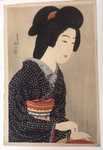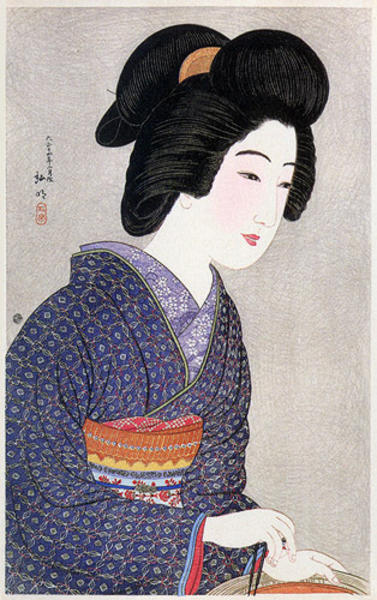| | |
| Artist: | Shotei Takahashi (1871-1945) Hiroaki — 松亭高橋、弘明 |
| Title: | Girl by Brazier |
| Series: | |
| Date of first edition?: | 1925/2 |
| Publisher (first edition)?: | Watanabe Shozaburo — 渡辺 |
| Publisher (this edition)?: | Watanabe Shozaburo — 渡辺 |
| Medium (first edition): | Woodblock |
| Medium (this edition): | Woodblock |
| Format (first edition): | Large Oban
|
| Format (this edition): | Large Oban |
| DB artwork code: | 46452 |
| Notes (first edition)?: |
The pink on the cheeks of the bijin is very fugitive, i.e., a faded print will have little to no pink on the cheeks.
ARTIST: Hiroaki, Shotei, 1871-1944
SIZE: 15 3/8 x 9 5/8 inches
DESCRIPTION: Title: Girl by Brazier
Date: 1925 February
Notes: Published by The Watanabe Color Print Co.; round 6 mm seal; first state pre-war printing
MEDIUM: woodblock |
|
| Notes (this edition)?: |
| The following information was taken from the original web listing of this artwork. Note that there may be some inaccuracies:
Takahashi Shotei 高橋 松亭 (1871-1945) painted this ukiyo-e in 1925. You see a geisha with a brazier. The painting is showing extraordinary details. Look at the pattern of the kimono, obi and even at the hair. The face in contrast is plain white, because of the mask-like makeup, but she is not expressionless. She is pushing two sticks into a brazier. They look like incense sticks. Takahashi Shotei is a Japanese artist with a wide range of themes. If you like this painting, look for more works at wikiart. |
|
| Artist Bio: |
Takahashi Shotei was born in Tokyo with the given name of Takahashi Katsutaro. At a young age he was trained in Nihon-ga , the traditional Japanese painting style by his uncle Matsumoto Fuko, and beginning around 1907 Shotei started designing for the Watanabe Color Print Company. Shotei was among the first designers to be recruited into Watanabe's stable of artists, which would later expand to include Goyo, Shinsui, Hasui, Kasamatsu, Koson and Koitsu among others. Many Watanabe prints were designed for export, primarily to North America, where the demand for all things Japanese was high in the early 20th century.
By 1923 Shotei had produced nearly 500 designs for Watanabe, when Tokyo was hit by the Great Kanto earthquake -- the worst recorded natural catastrophe in the history of Japan. The fires ignited by the earthquake raged for three days, and Watanabe's print shop and all the woodblocks created by Shotei and the other early shin hanga artists, were destroyed.
After the earthquake Shotei created another 250 prints mostly depicting scenic Japanese landscapes in the shin hanga style he had helped to define. He continued to work for Watanabe, but also worked with the publishers Fusui Gabo and Shobido Tanaka, where he had more control over the finished print than was possible with Watanabe.
Shotei used a variety of names, signatures and seals during his lifetime. From 1907 until 1922 he used the name Shotei, and after 1922 Hiroaki and Komei.
|
|







